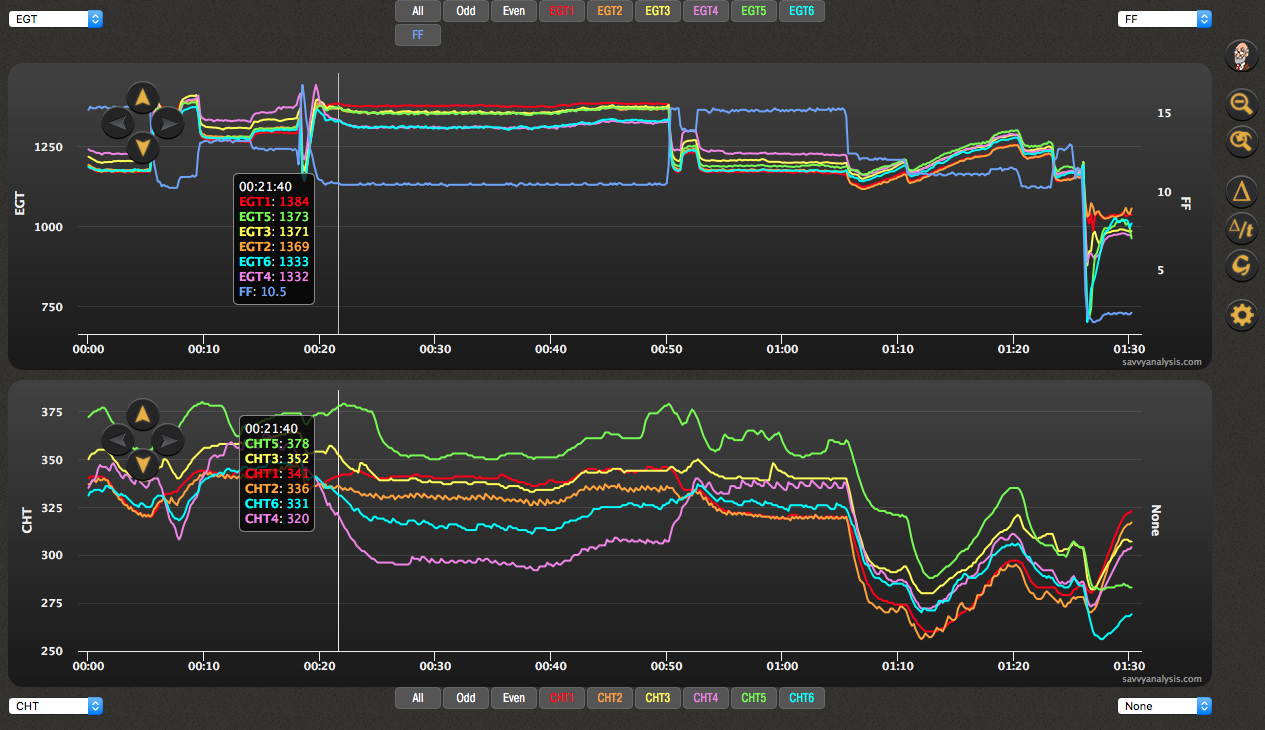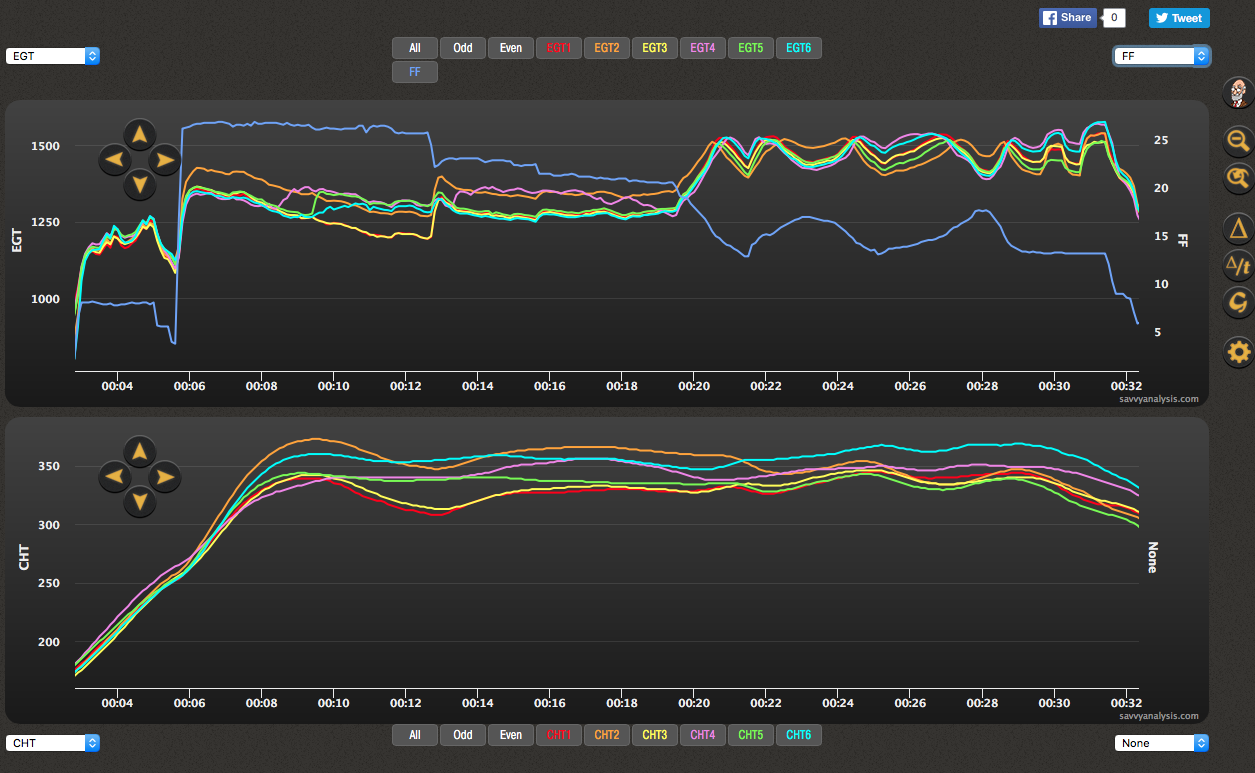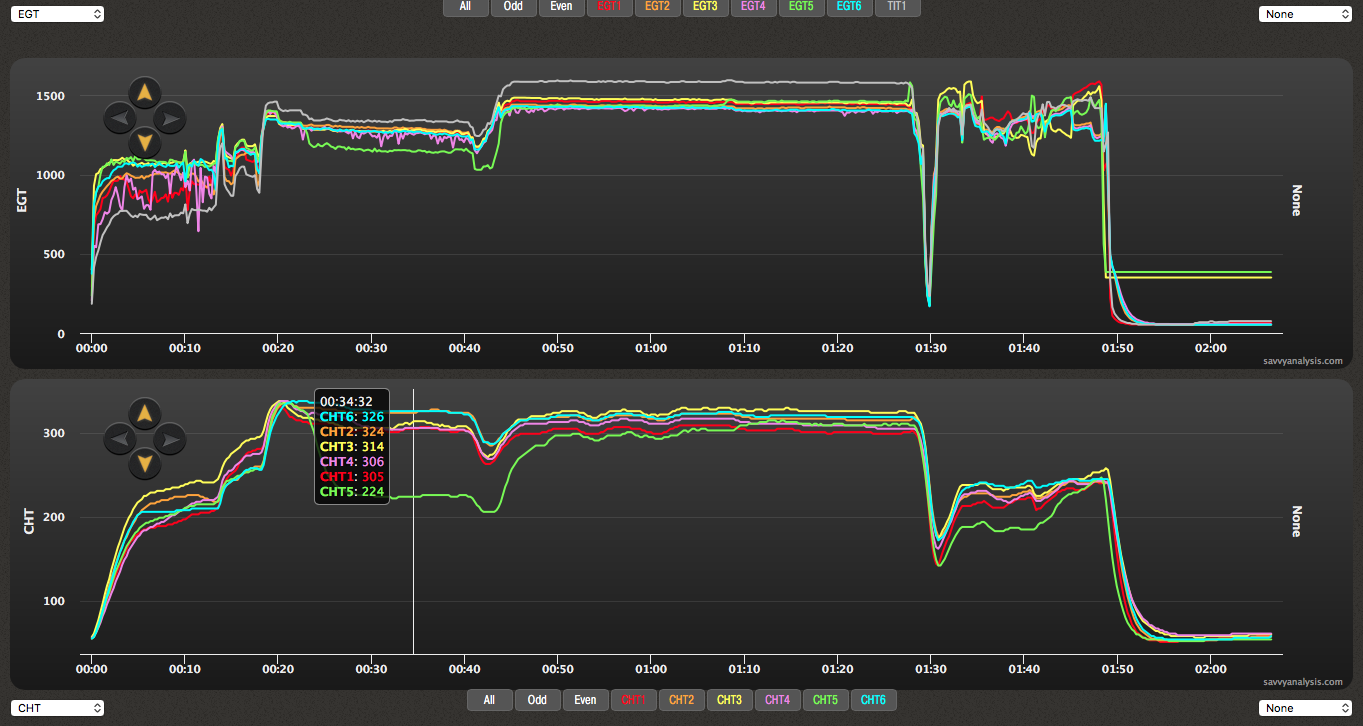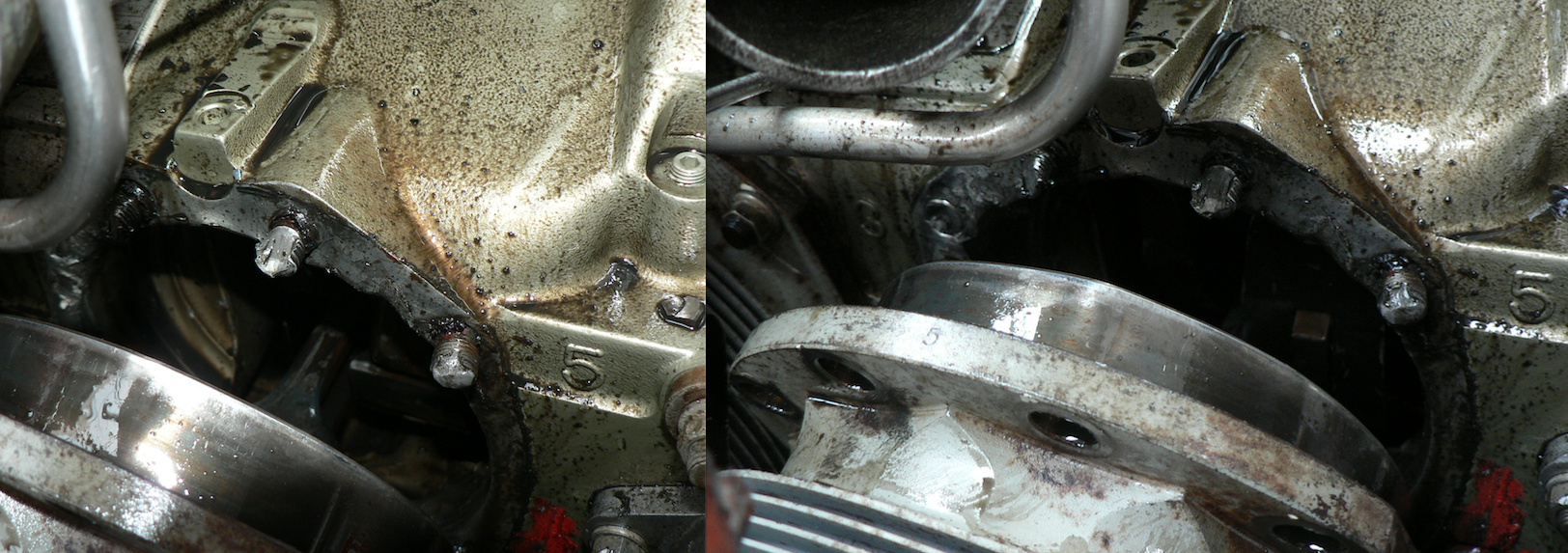I MIFfed my airplane this week. I was installing the passenger seat in my Bellanca Viking – something I’ve done many, many times over my 26 years of ownership, and broke a weld between the seat frame and the seat rail. It’s not a huge repair, and considering how many times it has been in and out of the airplane and the various derrieres that have graced that seat since it left Minnesota in 1974, it’s surprising it lasted this long.
Savvy’s founder Mike Busch has written extensively on the topic of maintenance induced failures, but I’ve seen some analysis data lately that appears to be MIFs, so I thought I would tackle them in this month’s Puzzler.
Let’s start with data from a Beech 35 Bonanza with a Continental IO-470-C. EGTs are on top with FF – the blue trace – overlaid. CHTs are on bottom.

The flight is already in progress when the data begins – FF is about 15 GPH – and EGTs are stable. They move and change rank through the leaning process which ends at about the 21 min mark, then they’re stable until FF increases at about the 50 min mark. CHTs are another story. The good news is CHT 5, the highest, doesn’t exceed 380º. It’s also probably good news that EGTs are stable and don’t appear to be causing these erratic CHTs. If it’s not combustion, it must be cooling.
The bottom cowl on the Viking is a pain to remove. Dan Torrey at MARS in Santa Paula can do it with the nose gear down. I’ve tried his method, but experience tells me that there will be less cursing and bleeding knuckles if I retract the gear then pull the lower cowl. On the Viking, once both cowls are off you have excellent access to your workspace. Then there’s the Bonanza. Granted, it’s a lot easier to get into the passenger seat of a Bonanza than a Viking, but the gull-wing access panels on the Bo complicate engine work.
In the case of this Bonanza, CHTs were better before the maintenance, so something got moved, or bent or tweaked to change the cooling patterns. Some cooling problems only occur when 100+ knots of wind are present – tough to replicate on the ground. Data shows that the 1-3-5 side is a little worse than the 2-4-6 side in terms of high temp, but the small and frequent oscillations in CHTs 2-4-6 are different than the longer and more shallow patterns in 1-3-5. Further complicating things, the both-high-together-when-ROP and both-low-together-when-LOP patterns of EGT and CHT 4 — the purple traces – could be from a partially clogged injector.
Next up is a post-annual flight from a Cirrus SR22 with a Continental IO-550-N. Again, EGTs and FF are on top, CHTs on bottom.

In climb, starting about the 6 min mark, EGT and CHT 2 show the high-together pattern of an injector clog. We find corroboration in the GAMI sweeps starting about the 20 min mark. EGT 2 is first to peak, another sign that it’s running lean. Injectors had been cleaned during the annual, but the data suggests cleaning #2 again.
During climb, EGTs 4, 5 and 6 – purple, green and cyan – also jump up as 2 had done earlier. Those CHTs don’t climb as 2 had done earlier, but they don’t fall at the 10 min mark as 1, 2, and 3 do, so that sort of counts as a rise. 4’s patterns aren’t as “textbook” as 2, but this also suggests cleaning the injector – vs something with the plugs. The patterns for 5 and 6 are even less definitive, and they look ok from the first FF reduction through the remainder of the flight with lower FF. But they did seem to have an issue handling FF above 25 GPH, so our recommendation would be to clean injectors 2, 4, 5 and 6 – even though they had been reported as clean in the annual.
Next up is data from a Piper Mirage with a Lycoming TIO-540-AE2A.

CHTs are on bottom, TIT is on top. I’d like to be able to show you EGTs, but Piper decided that they would sell this million-dollar airplane without EGT probes. The Garmin G1000 in the panel will accept them, along with all the other data you see listed on the pull-down menu on the right, but Piper doesn’t install EGT probes. Instead, their recommendation is to use TIT for leaning. Without EGT probes, we can’t offer advice on clogged injectors, or weak spark plugs, or mag timing. Worse, only referencing TIT means the pilot may have chosen a FF that keeps CHTs in a good range, but EGTs might be at or near peak, or in the “red fin” of maximum cylinder pressure. We wouldn’t know.
We also don’t know who at Piper suggested this change. Even the Mirage’s little brother the Warrior has EGT probes. It seems unlikely that engineers would have suggested less-is-more. It doesn’t make sense from a marketing standpoint – is another few hundred dollars for useful engine data going to have a big impact on sales of a million-dollar airplane? This doesn’t exactly qualify as a MIF – let’s call it a DIF, a design-induced flaw. We would highly recommend that any Mirage or Malibu owner without EGT probes install them at the next opportunity.
Next up is data from the left engine of a Cessna 421 Golden Eagle with a Continental GTSIO-520-N.

Takeoff is just before the 20 min mark. During taxi, EGT 4 – the purple trace – was erratic. It’s less erratic after the runup, but shows spikes through climb and cruise. But that’s not the big elephant in the room. Just after takeoff, cyl 5 – the green traces – show a moderate drop in EGT and a substantial drop in CHT. At the big mixture pull around the 45 min mark things improve, and by the hour-and-ten mark EGT and CHT 5 look normal again.
But there was continued and escalating roughness, so after experimenting with power settings, the pilot elected to shut down the left engine at about 01:50 and made a single-engine landing. When they pulled the cowl to investigate, this is what they found – one of the most dramatic pictures of a catastrophic failure of the studs on a #5 cylinder that we’ve seen yet.

Connecting the dots, it looks like #5 did ok during taxi and runup, also ok on the takeoff roll, and shows its first sign of trouble a few minutes into the flight. Had these bolts sheared completely as depicted in the photos, it’s likely that oil would have pumped overboard requiring shutdown at that point. We’ve speculated about friction and heat and how that cylinder stayed on the case and how the data from that cylinder seems to improve over the course of the flight.
This is a world-class MIF with an astonishingly happy ending, and suddenly my little seat rail problem doesn’t seem so bad.